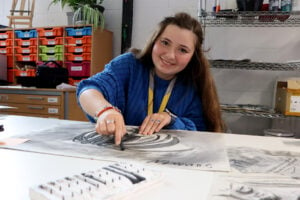Choosing your next step in Construction may feel overwhelming, especially if you aren’t sure which trade to specialise in.
That’s why we’ve put together this handy guide to our trade options, to give you a closer look at what’s available in College. Whatever your choice, each one offers something unique and a successful route into a promising Construction career.
Find out below what each involves, the skills you’ll learn on our courses, and what it’s really like to study at College:
Bench Joinery:
Bench Joinery is the craft of working with wood to create everything from doors, windows, staircases and furniture to bespoke interior fittings.
Bench joiners work mainly in a workshop, using both traditional hand tools and modern machinery to shape, assemble and finish wooden components with precision.
What skills do I need for Bench Joinery?
In Bench Joinery, you’ll need excellent attention to detail and a steady hand, as accuracy is key when measuring, cutting, and assembling wood.
On our courses, you’ll learn about different types of timber and sheet materials, how to use industry-standard tools and equipment, and how to follow technical drawings to bring projects to life. You’ll also develop strong problem-solving skills and learn about finishing techniques to give your work a professional look.
Where will I learn?
Our fully equipped joinery workshops are where you’ll have key experiences with woodworking machinery and tools. From sawing timber to assembling and polishing finished pieces, it’s here you can showcase your craftsmanship and create impressive joinery projects.
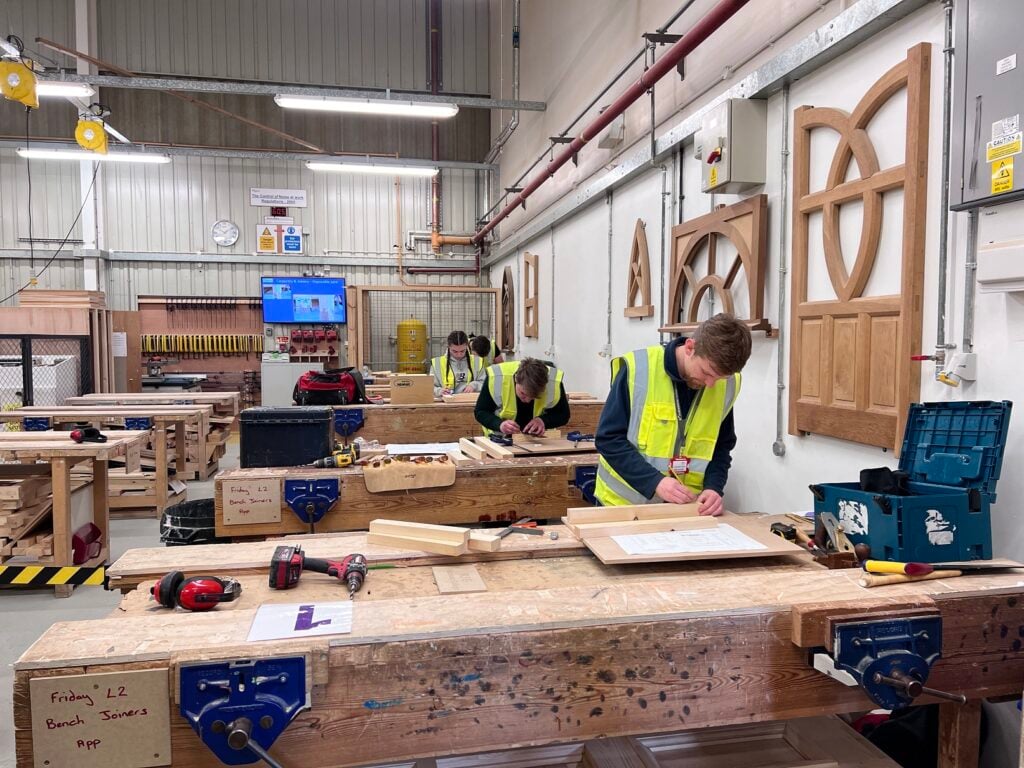
What do students like?
“I love the challenge of the subject itself. Bench Joinery is all about precision and attention to detail. I loved the range of projects we had on both the Level 2 and the Level 3 course, and the technical knowledge and skills that we developed.
“I knew I would miss the workspaces and workshops when I left, and I was right to think so. I don’t think any other space in the South East comes close.” – Beth, Level 3 Bench Joinery
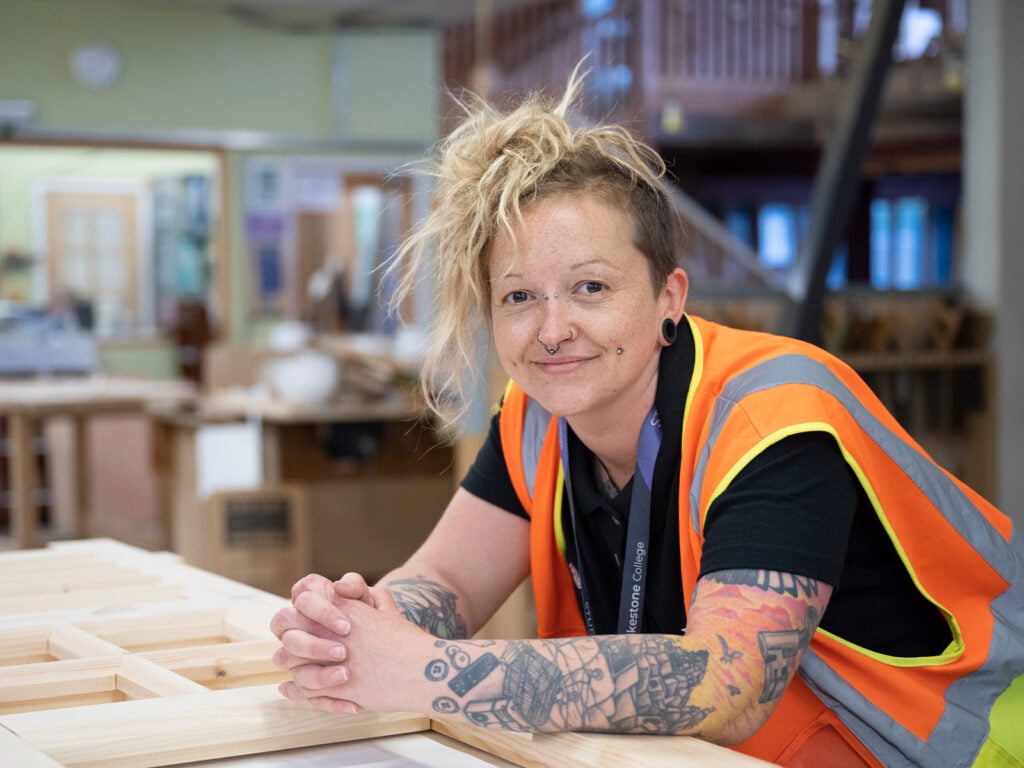
What’s a fun historical fact around Bench Joinery?
The famous Globe Theatre in London, originally built in 1599 for Shakespeare’s plays, was reconstructed in the 1990s using traditional joinery techniques.
Skilled joiners rebuilt the timber-framed structure using methods that would have been familiar more than 400 years ago.
Bricklaying:
Bricklaying is the art and skill of building with bricks, blocks, and mortar. Bricklayers construct and repair walls, chimney stacks, tunnel linings, and even decorative features like archways.
What skills do I need for Bricklaying?
In Bricklaying, you’ll need a good eye for detail and the ability to work accurately and efficiently.
On our courses, you’ll gain a solid understanding of different types of bricks and construction methods. In addition, you’ll discover how to read technical drawings, calculate measurements and angles, and have good problem-solving skills.
Lots of work for Bricklayers takes place outdoors, which means you’ll need to be comfortable working in all weathers.
Where will I learn?
On our courses, you will learn in our Bricklaying workshop. This space is where you will be getting your hands dirty in the workshop, as you mix cement and select bricks, before delivering them to your workstation.
In this open-plan space, you’ll start building the foundations of your bricklaying career while showcasing your skills to staff and classmates.
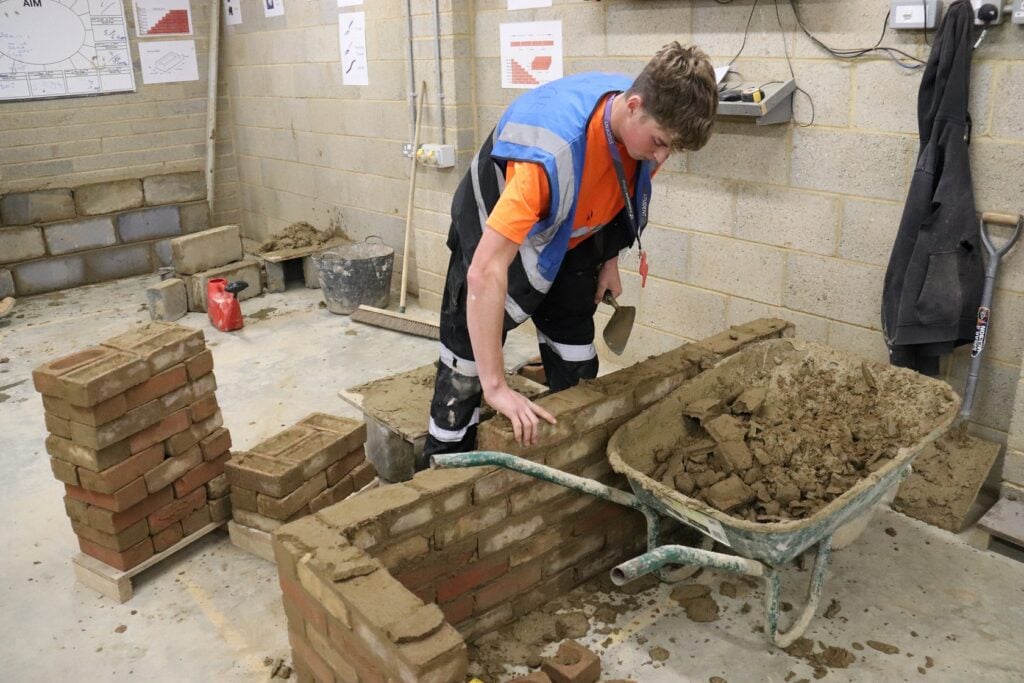
What do students like?
“I chose to study at College because it allows me to gain that academic knowledge as well as on-site experience. Doing a course in the trades allows me to specialise in something I’m passionate about.” – Jack, Level 3 Construction
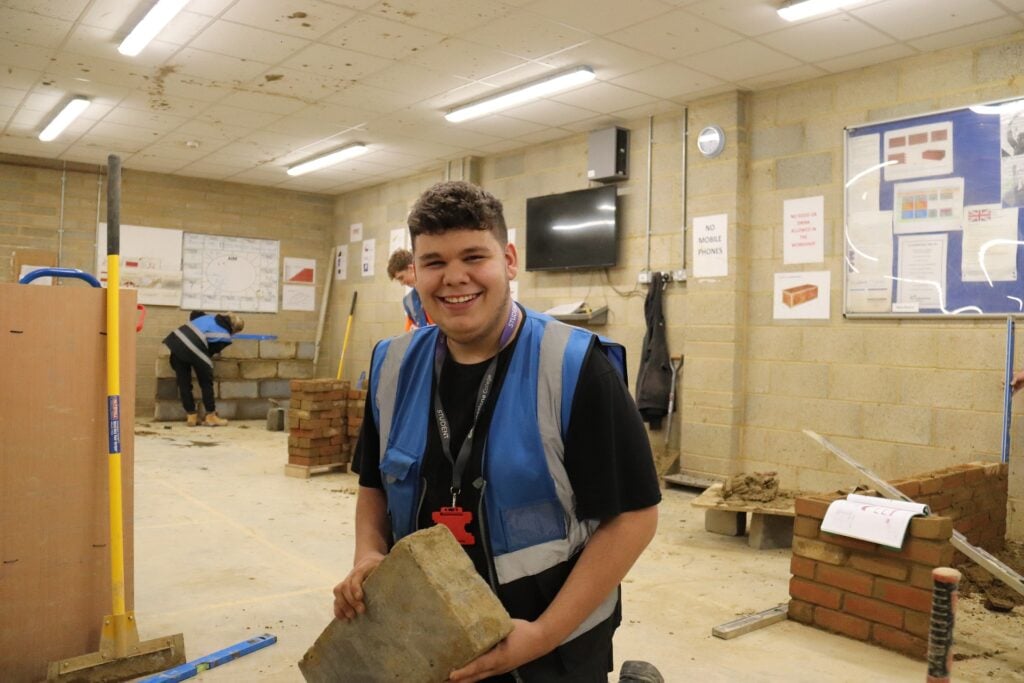
What’s a fun historical fact around Bricklaying?
The Great Wall of China, which is one of the most iconic structures in the world, was built using millions of bricks and stretches over 13,000 miles. Parts of it are more than 2,500 years old, showing just how long-lasting brickwork can be.
Carpentry:
Carpentry is the skill of working with timber to construct, install, and repair building frameworks and fittings.
Carpenters work on everything from roofs and floors to staircases, doors, and skirting boards. It’s a trade that demands precision, problem-solving, and creativity, as you turn raw materials into finished structures.
What skills do I need for Carpentry?
In addition to the above skills, to succeed in Carpentry, you’ll need good practical skills, an eye for detail, and the ability to measure and cut accurately.
On our courses, you’ll be introduced to the fundamentals of woodwork, carpentry, and joinery. You’ll learn about the construction industry, health and safety in the workplace, and how to manufacture standard joinery products. Carpentry often involves problem-solving on the spot, so you’ll also build resilience and adaptability, which are valuable skills on any site.
Where will I learn?
Carpentry students train in our dedicated Carpentry Workshops. These are a hive of activity, packed with top-of-the-range equipment, from saws to drills, with individual workstations and dedicated bay areas that simulate construction sites.
By working on a range of intricate structures such as roofs and doors you’re prepared for work in the industry, supported by expert lecturers with years of professional experience.
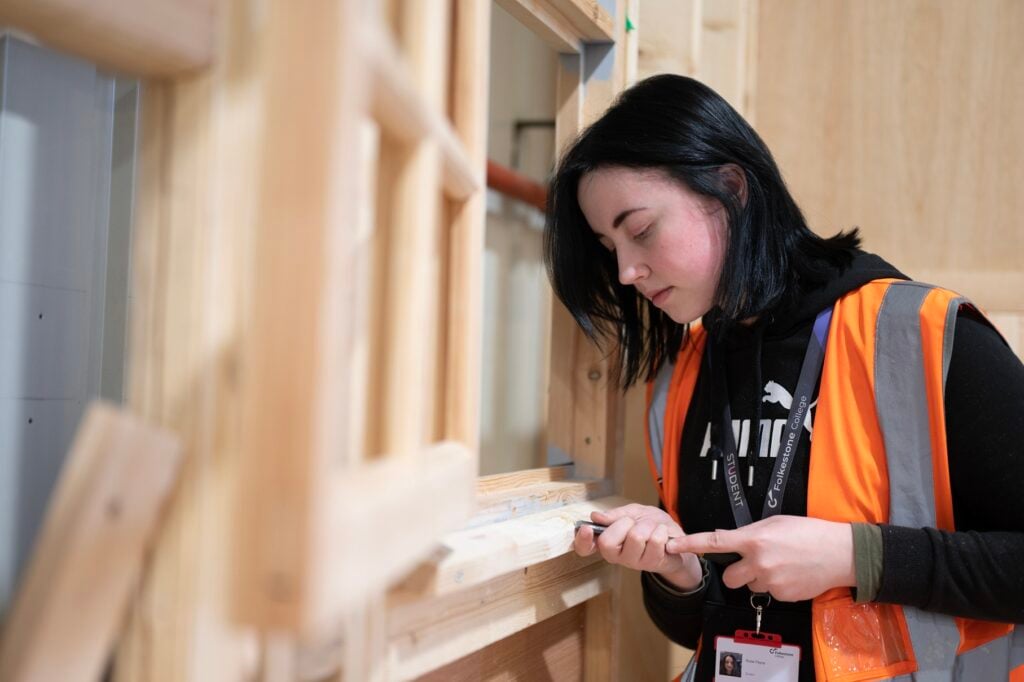
What do students like?
“The machine workshop is really modern and you get lots of experience here at Folkestone with all the tools.
“It’s really nice as well that I can give back to the community and inspire people in projects throughout the year, such as by planting trees with local schools.”- Charlie, Level 2 Furniture Manufacturer Apprentice

What’s a fun historical fact around Carpentry?
The roof of Westminster Hall in London, built in the 1390s, is one of the largest medieval timber roofs in Europe. It was constructed by master carpenters using oak beams so huge that some weighed over 10 tonnes – and it’s still standing strong more than 600 years later.
Painting and Decorating:
Painting and Decorating is the craft of transforming spaces with colour, texture, and design. Painters and decorators work on everything from homes and offices to large commercial projects, using paint, wallpaper, and finishes to create both protective and decorative surfaces.
What skills do I need for Painting and Decorating?
To succeed in this trade, you’ll need a steady hand, an eye for design, and the ability to work neatly and accurately.
On our courses, you’ll learn how to prepare surfaces, apply different types of paint and wallpaper, measure and cut materials precisely, and use specialist tools to achieve professional finishes.
You’ll also build your creativity and problem-solving skills as you experiment with colour schemes, textures, and decorative techniques that bring your ideas to life.
Where will I learn?
In our Painting and Decorating workshops, you’ll take ownership of your own bay, which is a space designed to replicate a room.
Here, you’ll plan, measure, and create your designs, whether that’s painting smooth finishes, cutting wallpaper to size, or experimenting with bold decorative styles. Each bay is your canvas, giving you the freedom to showcase your skills in a practical way.

What do students like?
“So far I’m happy with the quality of my work, I’m particularly happy with how well my base colours have applied and I’m fairly confident in my measurements.
“I think taking part in competitions like KFE4Skills is really helping with my time management skills. It’s pushing me to work quickly and efficiently but also try and be as precise as possible, which will help when I’m completing jobs in the real world.” – Katie, Painting and Decorating Apprentice

What’s a fun historical fact around Painting and Decorating?
The earliest known use of wallpaper dates back to the 16th century in Europe, where artisans hand-painted large sheets of paper to decorate walls. Today’s wallpaper may be printed by machine, but the skill of applying it neatly is still very much a craft.
Plastering:
Plastering is the skill of covering walls and ceilings with smooth layers of plaster to create strong, even finishes that are ready for decoration. Plasterers also repair and restore damaged surfaces and can work on decorative mouldings and finishes for interiors.
What skills do I need for Plastering?
In Plastering, accuracy and patience are essential, as even the smallest mistake can affect the finish. You’ll need good hand–eye coordination and a steady hand to apply and smooth plaster effectively.
On our courses, you’ll gain a solid understanding of plastering materials, tools, and techniques. You’ll learn how to prepare different surfaces, apply plaster across walls and ceilings, and develop the confidence to produce flawless results.
Where will I learn?
In our dedicated plastering workshops, you’ll gain experience applying and smoothing plaster to walls and ceilings. These spaces are designed to replicate working environments, building your skills and confidence with every task.
With support from experienced lecturers, you’ll have the opportunity to showcase your craftsmanship and prepare for your career as a skilled plasterer.
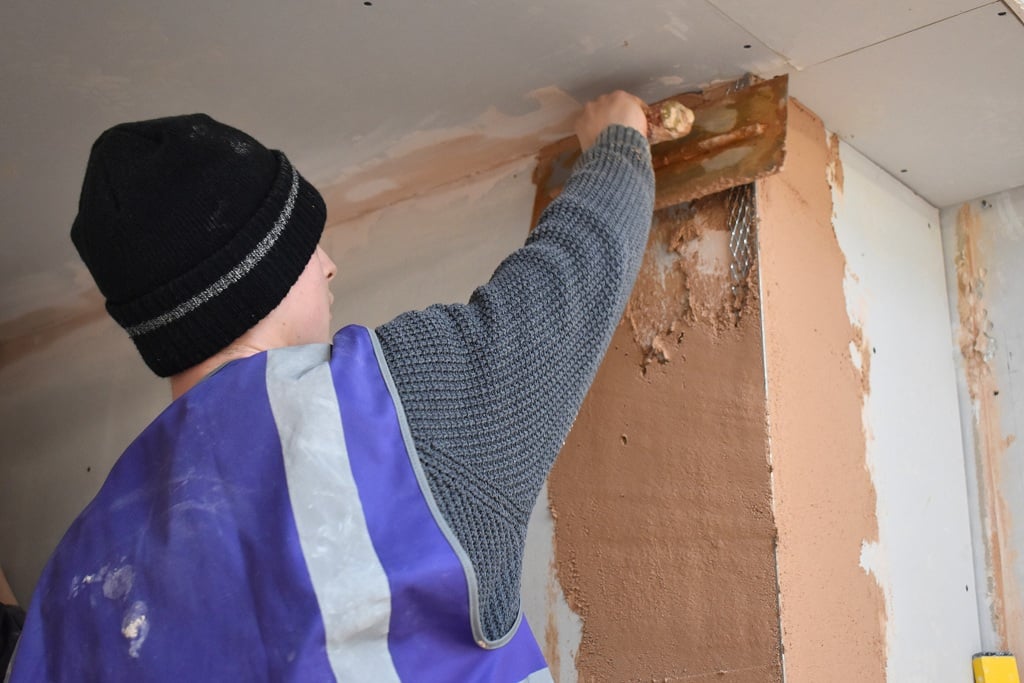
What do students like?
“I’m looking forward to putting my skills into practice. It’s wonderful to learn and I want to keep doing more of the same. I’ve now got skills so I can practice further and learn more which is what I want to do.
“I’m finding it fairly easy to manage my life with studying here. It’s an eye-opener to come back to College, and the College environment is very supportive.” – Nigel, Introduction in Plastering Skills

What’s a fun historical fact around Plastering?
Did you know some of the plasterwork inside the ancient Roman city of Pompeii is still visible today? Despite being nearly 2,000 years old, many of the decorative plaster walls and ceilings survived the eruption of Mount Vesuvius, proving just how durable skilled plastering can be.
Whether you see yourself building, crafting, fixing or designing, a trade career can open the door to exciting opportunities. Our courses give you the skills, confidence and experiences you need to succeed, and it all starts with your application.
If you’re ready to take the next step or inspired by what you’ve read, don’t wait around. Apply today and begin your journey towards a career you can be proud of.
